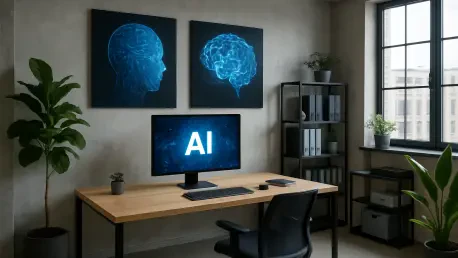Picture a landscape where technology advances at an unprecedented pace, fueled by artificial intelligence (AI) that transcends being just a tool to become a fundamental driver of change, revolutionizing the tech industry and redefining how companies operate. This powerful force is also uncovering fresh avenues for investment. From automating routine operations to carving out entirely new market segments, AI stands at the forefront of a transformation that is altering labor dynamics and business strategies across the board. This shift is not merely about efficiency; it’s about reimagining possibilities in sectors ranging from financial services to cybersecurity. As AI continues to penetrate deeper into the fabric of technology, it brings with it both challenges and prospects that are reshaping economic landscapes. This exploration seeks to uncover the profound ways in which AI is influencing various tech domains while spotlighting undervalued opportunities that await discerning investors in this rapidly evolving arena.
AI Driving Technological Evolution
The impact of AI on technology cannot be overstated, as it serves as a pivotal force propelling innovation across diverse fields. Far beyond a trendy term, AI is automating intricate processes in areas such as software development, financial services, and cybersecurity, enabling companies to achieve remarkable efficiency gains. For instance, in financial services, AI refines risk modeling, allowing for more accurate predictions and tailored customer interactions. Similarly, in cybersecurity, it powers advanced threat detection systems that protect against increasingly sophisticated attacks. These advancements are not mere incremental improvements but represent a fundamental reinvention of operational models. As AI integrates deeper into these sectors, it creates substantial value by unlocking markets that were previously inaccessible, setting the stage for a new era of technological capability that reshapes competitive dynamics.
Moreover, the transformative nature of AI extends to fostering innovation in unexpected corners of the tech world. Companies leveraging AI are not just streamlining existing workflows but are also pioneering solutions that address emerging needs. Take the example of AI-driven analytics in enterprise software, which helps organizations navigate complex regulatory landscapes with greater ease. This ability to adapt and innovate positions AI as a cornerstone of modern tech evolution, encouraging firms to rethink traditional approaches. Beyond operational enhancements, AI’s influence is evident in how it catalyzes the creation of entirely new products and services, pushing boundaries that once seemed fixed. For investors and industry leaders alike, understanding this shift is crucial, as it highlights the potential for growth in sectors that are aligning with AI’s expansive capabilities, promising substantial returns for those who act strategically.
Workforce Dynamics in the AI Era
AI’s influence reaches far beyond technology itself, profoundly altering the labor market in ways that challenge conventional norms. As automation takes over repetitive tasks, traditional roles, particularly in entry-level programming, are diminishing at a noticeable rate. However, this displacement tells only half the story; the other half is the emergence of new opportunities that demand specialized expertise. Roles focused on AI model management, system integration, and edge network optimization are seeing a surge in demand, reflecting a shift toward more complex, technology-driven skill sets. This duality of job loss and creation underscores the need for companies to adapt by prioritizing reskilling initiatives, ensuring their workforce remains relevant in an AI-dominated landscape where agility is paramount.
In tandem with these shifts, the emphasis on human-AI collaboration is becoming a defining factor for organizational success. Firms that invest in training programs to bridge the gap between existing skills and emerging needs are better positioned to thrive amidst rapid change. This approach not only mitigates the risk of obsolescence but also fosters a culture of innovation where employees and AI systems complement each other’s strengths. For instance, while AI can handle vast data analysis, human oversight ensures ethical considerations and contextual understanding remain intact. The labor market’s evolution, therefore, is not a zero-sum game but a reconfiguration that rewards adaptability. As this dynamic unfolds, it becomes evident that the future of work will hinge on the ability to balance technological integration with human ingenuity, shaping a workforce that is both resilient and forward-thinking in the face of AI’s relentless advance.
Uncovering Hidden Investment Potential
For those with an eye on investment, AI’s pervasive impact reveals a treasure trove of undervalued sectors brimming with potential. Fields such as AI-driven financial services, quantum computing, next-gen IT services, electric vehicle (EV) sensor technologies, cybersecurity, and enterprise software are currently underappreciated by the broader market. Specific companies within these domains are trading at significant discounts to their fair value, presenting a unique window for strategic investment. By targeting firms that harness AI to address niche demands—whether it’s enhancing fraud detection or optimizing EV efficiency—investors can position themselves to capitalize on growth that remains largely unrecognized. This approach requires a keen understanding of how AI amplifies value in these sectors, offering a pathway to substantial returns.
Delving deeper, the diversity of these undervalued sectors highlights the broad applicability of AI as an investment catalyst. In cybersecurity, for example, the rise of distributed AI workloads and 5G adoption fuels demand for robust protective solutions, while quantum computing represents a high-risk, high-reward frontier with exponential growth projections. Similarly, enterprise software firms focusing on compliance in an AI-driven regulatory environment are carving out essential niches. These opportunities are not fleeting trends but are tied to structural shifts in technology adoption, suggesting durability in their growth trajectories. Investors who look beyond surface-level market sentiment to focus on the underlying fundamentals of AI integration will likely uncover gems that promise long-term appreciation, making now an opportune moment to explore these less-trodden paths in the tech investment landscape.
Capitalizing on Broader Industry Trends
AI’s transformative power gains even more significance when viewed through the lens of broader, unstoppable industry trends that shape the global economy. Its intersection with movements like electrification in EVs, the widespread adoption of 5G networks, and escalating regulatory requirements for compliance creates a robust foundation for sustained growth across multiple sectors. Companies involved in developing EV sensors, for instance, are critical to enhancing vehicle efficiency, while those crafting compliance tools for enterprise software address pressing needs in a tightly regulated world. These alignments with secular trends ensure that AI-driven advancements are not isolated phenomena but part of a larger, enduring shift, offering investors a stable platform for long-term commitments with promising upside.
Furthermore, the synergy between AI and these macro trends amplifies the resilience of affected sectors against short-term market fluctuations. The push for electrification, supported by governmental policies and consumer demand, guarantees a steady need for AI-enhanced technologies in automotive applications over the coming years. Similarly, the rollout of 5G infrastructure necessitates advanced cybersecurity measures powered by AI to safeguard expanding digital ecosystems. This convergence of technology and societal shifts creates a compelling case for investment in firms that are strategically positioned at these crossroads. By aligning portfolios with companies that not only adopt AI but also tie their innovations to these larger currents, investors can mitigate risks while tapping into growth narratives that are likely to persist, shaping the economic landscape for decades ahead.
The Competitive Edge of Adaptability
In an era dominated by AI, the ability to adapt emerges as the defining characteristic separating industry leaders from those left behind. Companies that seamlessly integrate AI into their core operations or pivot to meet emerging challenges—such as securing distributed AI workloads or developing sophisticated fraud detection systems—stand out as frontrunners in their respective fields. This adaptability often manifests through strategic acquisitions that bolster technological capabilities or through comprehensive workforce retraining programs that align human skills with AI demands. Such proactive measures ensure that these firms remain competitive, capable of navigating the rapid pace of change that defines the current tech environment, and poised to deliver value in innovative ways.
Beyond internal adjustments, adaptability also reflects a broader mindset of anticipating market needs before they fully materialize. Firms that foresee the growing importance of cybersecurity in an AI-driven world or recognize the regulatory complexities introduced by automation are better equipped to capture market share. This forward-thinking approach is not merely reactive but strategic, positioning companies to lead rather than follow industry shifts. For investors, identifying this trait of flexibility is crucial, as it often correlates with sustained performance and resilience against volatility. By prioritizing investments in entities that demonstrate a capacity to evolve alongside AI’s advancements, there lies an opportunity to secure significant returns, capitalizing on the foresight and agility that define success in this transformative period.
Navigating Future Growth Pathways
Reflecting on the journey of AI’s integration into technology, it’s clear that the past few years marked a turning point for numerous sectors. The displacement of traditional roles contrasted sharply with the creation of specialized positions, reshaping labor markets in profound ways. Companies across financial services, cybersecurity, and quantum computing adapted by embedding AI into their frameworks, often trading at undervalued rates despite their potential. This period also saw the alignment of AI with secular trends like electrification and 5G, which provided a sturdy backdrop for growth even amidst short-term market turbulence. These developments laid the groundwork for a redefined tech landscape, where innovation and adaptability became synonymous with success.
Looking ahead, the focus shifts to actionable strategies for capitalizing on these transformations. Investors are encouraged to delve into sectors where AI continues to unearth value, prioritizing firms that exhibit flexibility and alignment with long-term trends. Exploring opportunities in undervalued areas such as EV sensor technologies or enterprise software for compliance could yield significant gains as market recognition catches up. Additionally, staying attuned to evolving labor demands ensures that investments support companies fostering human-AI synergy. By adopting a forward-looking approach, grounded in the insights gained from recent shifts, there’s a pathway to navigate the complexities of an AI-driven future, harnessing its potential to drive both technological progress and investment success.









